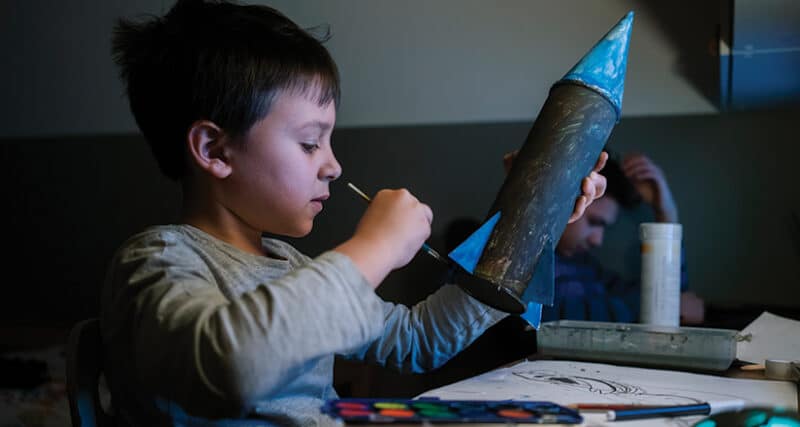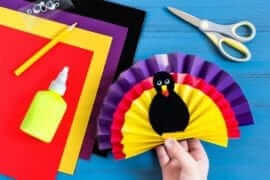S.T.E.A.M. Lessons On-the-Go: Four Easy Rockets
In these times of learning at a distance, many of us S.T.E.A.M. teachers have been caught off-guard. Not having uniform kits prepared for all of their students made conducting a virtual S.T.E.A.M. course challenging. Though many of us have (for now) returned to in-person learning, in this series, we are featuring lesson ideas for the S.T.E.A.M. teacher that can be completed with students virtually or in the classroom using items that can be found at home or acquired for a minimal cost. This is also an opportunity for children to get their parents involved in the learning process and bring some attention to your very cool S.T.E.A.M. program. Our recent lesson challenged students to design and build a floatable craft using only recyclable materials. This project will take them to the next level by exploring how Newton’s Laws explain how these simple rockets work.

Lesson Name: Random Rockets
Lesson Description: There’s nothing more exhilarating than watching a rocket launch. This project will use basic household items to build several different rockets.
Overview:
S.T.E.A.M. Integration
Science: The science behind this lesson is the law of motion that states, “when one body exerts a force on a second body, the second body simultaneously exerts a force equal in magnitude and opposite in direction on the first body.”
Technology: The technology is in the rocket’s source of power (chemical reaction in the case of the Alka-Seltzer rocket; air pressure in the case of the balloon and straw rockets).
Engineering: The engineering is in the design of the rocket and how it is built.
Art: Students have the freedom to decorate their rockets as they please.
Math: Mathematics enters this lesson with the measuring of the rocket’s launch distance.
Extend-Expand-Explore: Have students record the distances of their rockets on each flight. Have students redesign their rockets to make improvements to how they can fly.
Lesson Plan
Title: Random Rockets
Objective: To have students demonstrate Newton’s 3rd Law of Motion that when one body exerts a force on a second body, the second body simultaneously exerts a force equal in magnitude and opposite in direction on the first body.
Materials: balloons (round or long), 15 feet of string, plastic straws, tape, balloon pump, paper towel tube, large binder clips, scissors, tape measure, plastic film canister with a lid and tight seal, Alka-Seltzer tablets, measuring spoons, wax paper or bowl, spoon, water, vinegar, construction paper
Procedure (Balloon Rocket):
- Tie one end of the string to a chair or other support.
- Put the other end of the string through the straw.
- Pull the string tight and tie it to another support in the room.
- Blow up the balloon (but don’t tie it.) Pinch the end of the balloon and tape the balloon to the straw.
- Release the balloon to launch.
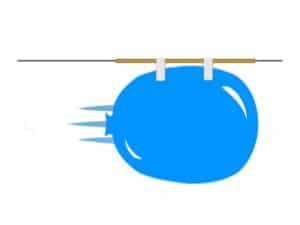
Procedure (Two-Stage Balloon Rocket):
- Cut a piece of string long enough to stretch across the room.
- Thread the string line through two straws, pull it tightly across the room, and then secure it at both ends.
- Cut a small, one-inch ring from the paper towel tube.
- Inflate one balloon and use a binder clip to pinch the balloon’s nozzle.
- Pull just the balloon’s nozzle through the cardboard ring, keeping it clipped shut.
- Thread another balloon partially through the cardboard ring, facing the same direction as the first balloon.
- Inflate the second balloon such that it presses up against the inside of the cardboard ring, squeezing the nozzle of the other balloon shut. You should be able to remove the binder clip from the first balloon and have it stay inflated.
- Use a binder clip to pinch the nozzle of the second balloon shut, and tape the balloons to the straws.
- Pull the balloons to one end of the string.
- Remove the binder clip from the nozzle of the second stage.
- Then, remove the binder clip from the nozzle of the first stage. The first stage should start to release air as it deflates, pushing the rocket forward. Eventually, it will deflate enough that it stops pinching the nozzle of the second stage shut against the cardboard tube, so the second stage will start to deflate, and continue traveling along the string while leaving the first stage behind.

Procedure: (Straw Rocket)
- From the construction paper, cut out a rectangle. This will be the body tube of the rocket.
- Wrap the rectangle around a pencil length-wise and tape the rectangle so that it forms a tube.
- Cut out and attach the fins from the construction paper. Cut out the two fin units.
- Tape the fins to the body tube and bend the fins 90 degrees so that they are each at a right angle to each other.
- Twist the top of the body tube into a nose cone around a pencil.
- Remove the pencil and replace it with a soda straw.
- Blow into the straw to launch your rocket.

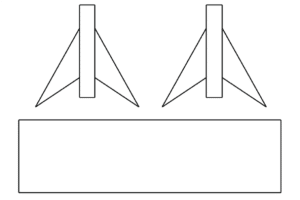
Procedure: (Alka-Seltzer Rocket)
- Tape 1 Alka-Seltzer tablet onto the lid of the film canister.
- Add 1 tsp. of vinegar to the canister at a time, filling it almost to the top. You need to add as much vinegar to the canister as possible without the vinegar and the Alka-Seltzer tablet coming into contact when you later snap the lid onto the canister. Depending on the exact canister, this may be around 5 tsp. of vinegar.
- Go outside to an open area at least six feet from buildings.
- Find a clear, flat area and quickly snap the lid onto the canister to seal it.
- Quickly turn the canister over, so the lid is on the ground, and get away.
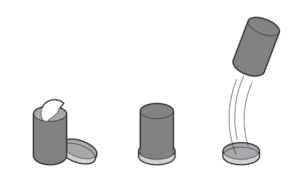
Conclusion: Have a group discussion with the participants. Ask them which rocket they liked best and why. Ask students which rocket went the highest. Ask students how they could improve upon each rocket type to get better performance out of it. Discuss Newton’s Third Law of Motion and how it applies to the rocket launch (When one body exerts a force on a second body, the second body simultaneously exerts a force equal in magnitude and opposite in direction on the first body).


